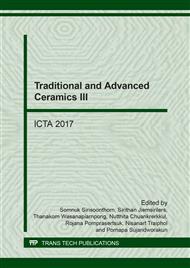p.83
p.88
p.94
p.99
p.105
p.111
p.117
p.122
p.127
Preparation of Consolidated Body Zeolite from Rice Husk Ash
Abstract:
Rice husks (RHs) are agricultural wastes which include approximately 20 mass% of silica (SiO2). In Thailand, RHs have been applied as fuel for thermal power generation systems and a large amount of ash (Rice husk ash: RHA) was produced. In addition, our research group has reported before that binder-free consolidated zeolite A could be obtained by using SiO2 powder with geopolymer reaction as a humidity conditioning material because zeolite A has been used as desiccant and builder for detergent with low silica content. Moreover, other kind of zeolite with high amount of SiO2 content, such as ZSM-5, was under interest due to its good properties as catalytic activity and a unique pore structure. But, it was not widely utilized because of the difficulty of consolidated body preparation. Therefore, in the present study, the possibility of the usage of RHA as raw materials for consolidated zeolite A and ZSM-5 was investigated for the high-value application of RHA under specific heat treatment condition, molar ratio and preparation technique. After specimens were obtained, XRD analysis and SEM were charactarized for consolidated bodies to confirm cystalline phases and observe microstructure, respectively. Consolidated zeolite A was synthesized with heat treatment above 60°C. The sample heat treated at 60°C for 24 h consisted of homogeneous zeolite A particles with the size smaller than 1 μm. In addition, consolidated ZSM-5 was synthesized with an usual method as TPABr (Tetra propyl ammonium bromide) technique and research method as S.C. (seed crystal) technique. The results showed that although around 10 μm seed crystal was used, around 4~5 μm of ZSM-5 particles were obtained by S.C. technique. This result led to the possibility to use RHA with S.C. technique to synthesize consolidated body and control ZSM-5 particle size.
Info:
Periodical:
Pages:
105-110
Citation:
Online since:
April 2018
Authors:
Keywords:
Price:
Сopyright:
© 2018 Trans Tech Publications Ltd. All Rights Reserved
Share:
Citation:


